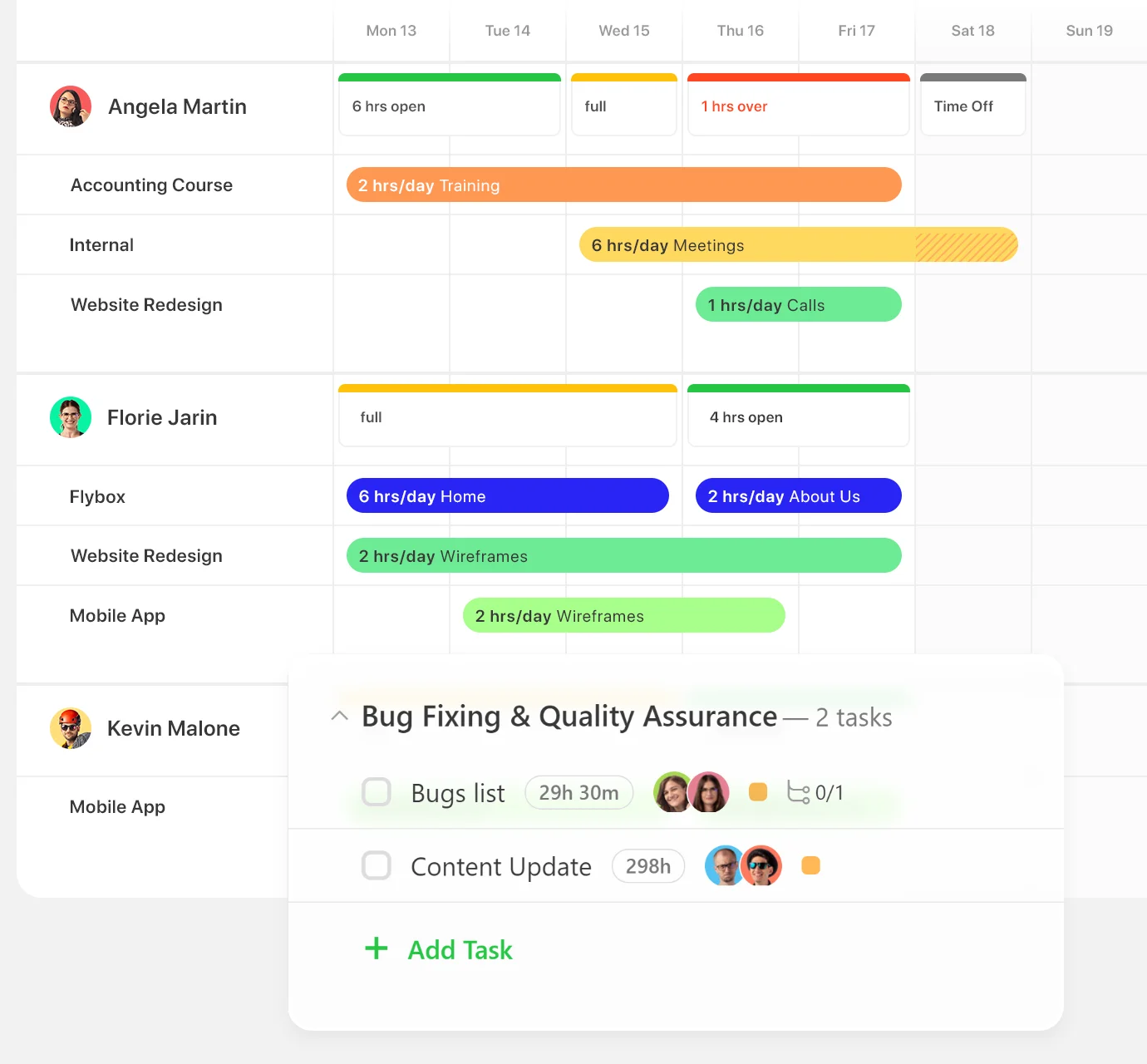If you’ve ever tried to coordinate a hybrid team, you know the feeling: it’s like herding caffeinated cats. Everyone’s moving fast, but in completely different directions. Sarah’s crushing it from her home office in Portland, while Jake’s juggling client calls from a co-working space in Miami, and your entire development team just went radio silent during their “focus time“—talk about hectic time tracking.
Sound familiar? You’re not alone.
Michael Englander, Director of Operations at NYREI, nailed it when he said:
“Time tracking in a hybrid team is like herding caffeinated cats — everyone’s moving fast in different directions. But once you get the right system in place, those cats start syncing up, and suddenly you’ve got a team that’s agile, accountable, and actually hitting deadlines.”
The promise is tantalizing: transform your chaotic, scattered team into a deadline-crushing machine. But here’s the reality check: it’s not as simple as downloading the latest time tracking app and calling it a day.
The difference between success and failure lies in understanding that time tracking isn’t really about the software at all (although there are some of the best time tracking software at affordable prices). It’s about people, processes, and getting everyone to buy into a system that actually works.
In this guide, I’ll show you exactly how to make that transformation happen, from choosing the right tools to overcoming the inevitable resistance from your team. Because when you get it right, those caffeinated cats don’t just sync up – they turn into a productivity powerhouse that would make any manager proud.
But before we dive into the how, let’s start with the why. Understanding the real value of time tracking in today’s business landscape is crucial – and it’s not what you might think.
Why time tracking matters for businesses today
“Businesses used to think of time tracking as a control mechanism. Now it’s a growth tool essential for forecasting, performance metrics, and team management.”
…as Robin Hau, the founder and CEO of USWired, astutely put it.
Time tracking today isn’t about making sure John from accounting doesn’t sneak out 30 minutes early on Wednesdays. With more teams working remotely or on flexible schedules, most businesses have moved away from measuring hours at a desk and toward tracking progress against goals.
Without visibility into time, you’re flying blind when it comes to profitability, productivity, and resource planning.
With the proper time tracking tool, you’ll know if John in accounting has too much free time on his hands right away. He doesn’t have to send you an email asking for more tasks, and he can’t just enjoy his free time until it’s time to punch out.

Overall, when you track time effectively, you gain:
- Clarity on what tasks eat up most of your team’s energy;
- Data to bill clients accurately and justify project timelines;
- Insights into whether your pricing model reflects the real cost of work;
- The ability to identify bottlenecks and optimize workflows.
Additionally, proper time tracking, whether you’re a large corporation or a solopreneur, is important when you calculate the costs with human resources (payroll, bonuses, social security, Medicare, etc.). After all, you want to make sure hard workers are compensated fairly and your taxes are in order.
Don’t think that if you’re a solopreneur, you don’t need a good time tracker! On the contrary, you’re the only one holding yourself accountable, so you need accurate data for pricing, billing, and taxes. Plus, if you’re a U.S. solopreneur living abroad, you may still be on the hook for some taxes back home, on top of the ones you have to pay in your new home country.
Jeroen Kooimans, Co-founder & CEO at Expatfile, stated how
“Many U.S. solopreneurs living abroad assume their income flies under the radar, but Uncle Sam doesn’t forget. Accurate time tracking helps you justify earnings, deductions, and foreign tax credits, which is critical when you’re juggling multiple tax systems.”
Common challenges (and how to solve them)
Despite its benefits, time tracking often gets a bad rap, and not without reason. If done poorly, it can feel like micromanagement or a bureaucratic chore. Add to this learning how to track remote team members, who may be in a different timezone, and you’ve got quite the conundrum on your hands.
But time tracking is not that difficult. Most of these frustrations stem from outdated tools or unclear processes, not from the concept itself.
Englander stated that it is essential to be aware of common challenges and prepare for them when they arise—here’s a few of them:
- It feels like you’re under surveillance – Some team members may feel like Big Brother’s watching, so reframe time tracking as a tool for empowerment. Make it clear that it’s used to identify workload imbalances and optimize time, not spy on anyone.
- Manual entry is a pain and prone to error – Use tools that offer automatic time tracking or integrations with project management software. These apps track time passively in the background and generate a report at the end of the day.
- No pre-defined schedule – Creative work, consulting, and multi-project environments don’t fit neatly into traditional time tracking molds. In this case, work with flexible categories like “deep work,” “client calls,” or “internal admin” to help teams log time without being overly granular.
- No one uses the data – If your team’s time logs sit in a folder somewhere, gathering digital dust, you’re leaving money on the table. Make sure the data is reviewed and use it to guide hiring decisions, improve project estimates, or consider pricing changes.

With Paymo Track, all you have to do is connect time entries to tasks. Download for free.
Features to look for in time tracking tools
Let’s be honest about it — a quick Google search on time tracking will produce a long list of tools, platforms, and apps that well… track time.
But, don’t they all do the same thing? Do we really need that many?
Well, it depends on what you want these tools to do. For instance, Paymo offers several extremely useful features, like team scheduling, leave planner, and automatic tracking (among others). However, some users may prefer a simpler option.
If you don’t know what to choose (that decision fatigue is kicking in), focus on what actually moves the needle for your business.
Here are some of the features most businesses want:
- Ease of use – Intuitive design, mobile access, and one-click timers.
- Automation & integrations – The best tools integrate with your project management, calendar, and accounting software, reducing double-entry and errors.
- Transparency & reporting – Clear dashboards and custom reports help improve billing accuracy, assess team capacity, and forecast project timelines.
- Scalability – Whether you’re a team of one or 100, the tool should grow with you. Start simple, but ensure that advanced features like client management, expense tracking, and permissions are available when needed.
Jessica Perkins, Content Strategist at BioProcress H2O, shared with us how the company improved operations just by implementing a time tracking policy:
“By monitoring task-level hours across project teams of engineers, biologists, and machinists, we gained clarity over workload distribution, project forecasting, and billing. Additionally, historical time data that we knew were accurate allowed our specialists to fine-tune estimates, which improved planning precision.”
Best practices for a smooth time tracking implementation
Finding the right tool, app, or platform for time tracking is only half of the solution. The other half is a successful implementation. This is where your team gets into the spotlight.
We asked a few successful business leaders to share their insights on a successful implementation:
Colin Matthes, the Co-Founder & CMO of FormPros:
“Time tracking won’t stick if your team sees it as a surveillance tool. When we rolled it out, we focused on simplicity first — just a few broad categories and a quick weekly check-in. We also involved our team early on, letting them help shape what we tracked and why. Once people realized it was about protecting their time and improving project planning, buy-in came naturally.”
Abheek Pandoh, the CEO of Knowt:
“We treat time tracking the way we treat product data: it’s there to help us learn and iterate. The key was sharing insights regularly — how long projects really take, where we’re over-allocating, what’s working. That transparency helped everyone understand the ‘why.’
It was also an amazing opportunity to build habits around it, like logging time right after our daily standup. This way, it became part of the rhythm, not an interruption.”
Rupert Jones, the owner of Finance Rupert Consulting:
“Time tracking is like bookkeeping — you ignore it at your own risk. I use it to track every client call, every admin task, and even downtime. That data helps me price my services more accurately, see when I’m overcommitting, and know when to raise my rates.
The best tip I can give: don’t overthink it. Use a simple app with a timer and just start. You’ll be surprised how fast it becomes second nature.”

Try the Pomodoro technique to get started with simple time tracking.
Track your success
“You can’t manage what you don’t measure.”
This quote by Peter Drucker is pretty straightforward: the right KPIs will tell you whether you’re on the right track or not. If you’re not following any KPIs, then you’re most likely not going in the direction of success.
So, let’s have a look at some of the KPIs that paint the picture of your time tracking implementation:
- Time logged vs. estimated – reveals scoping accuracy;
- Billable utilization rate – % of time spent on revenue-generating work;
- Time entry compliance – how consistently your team tracks time;
- Project profitability – shows true cost vs. income;
- Time to invoice – faster billing improves cash flow;
- Workload distribution – prevents burnout and improves balance;
- Time categorization accuracy – ensures data is useful, not vague.
You don’t need to track all of them at once. Start with two or three that align with your biggest business goals, then expand from there.
Bottom line
The right time tracking tool can help you make smarter decisions, improve profitability, and protect your most valuable asset: time. Whether you’re managing a team or flying solo, the right tools and habits can transform how you work. Ready to take control of your time and turn insights into impact? Try Paymo and start tracking smarter today!
Start tracking your work time now!

Tania Doshko
Author
Tania Doshko is a motivated and avid content creator who believes in the power of quality writing for business success. She finds her inspiration in careful observations and amazement with the fastly developing world.

Alexandra Martin
Editor
Drawing from a background in cognitive linguistics and armed with 10+ years of content writing experience, Alexandra Martin combines her expertise with a newfound interest in productivity and project management. In her spare time, she dabbles in all things creative.

